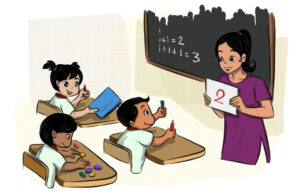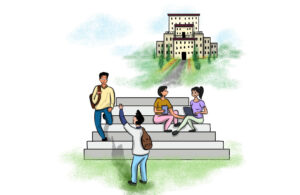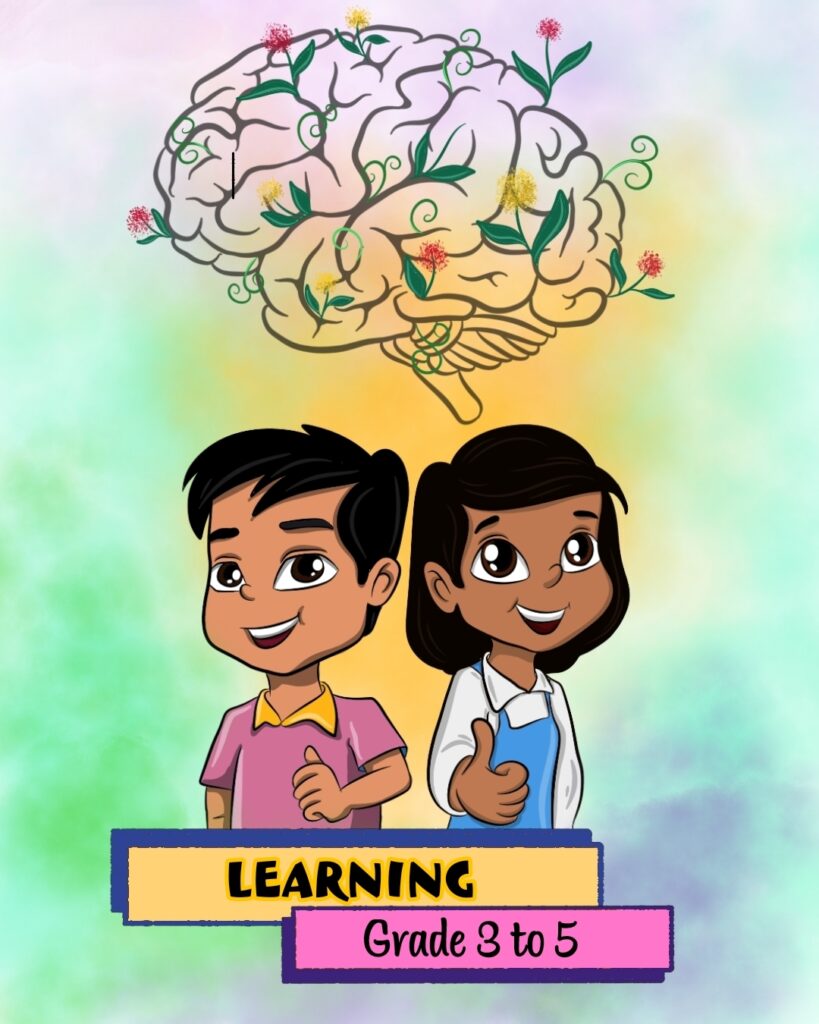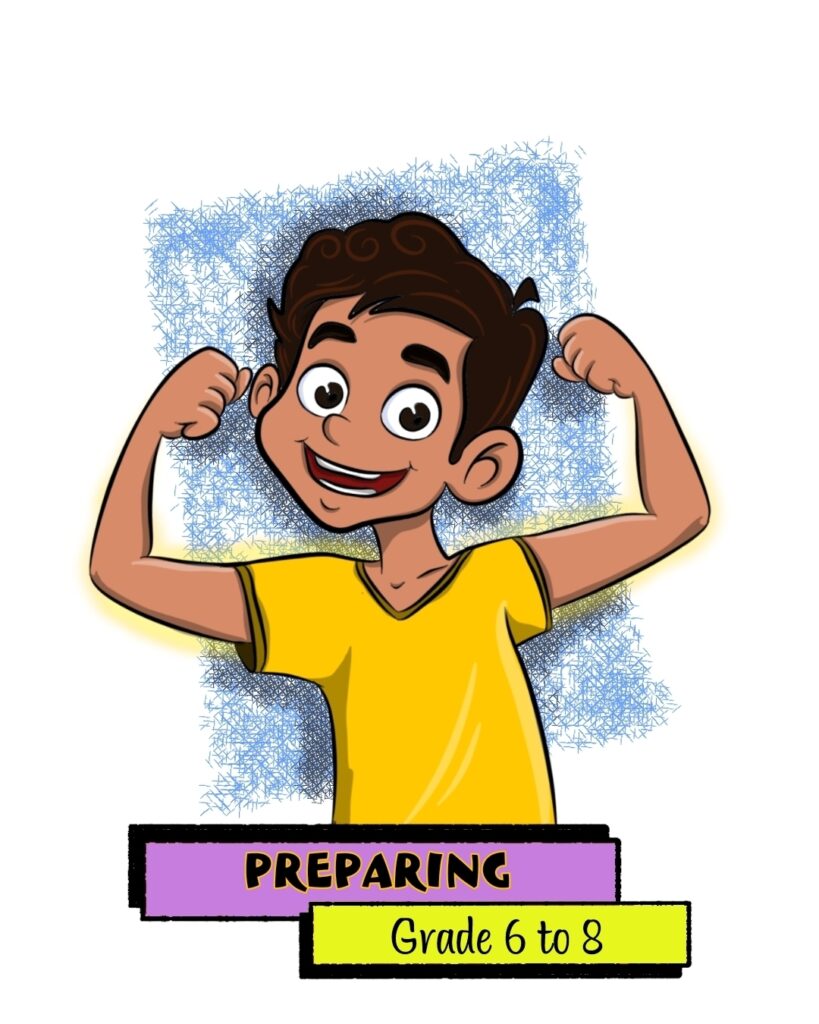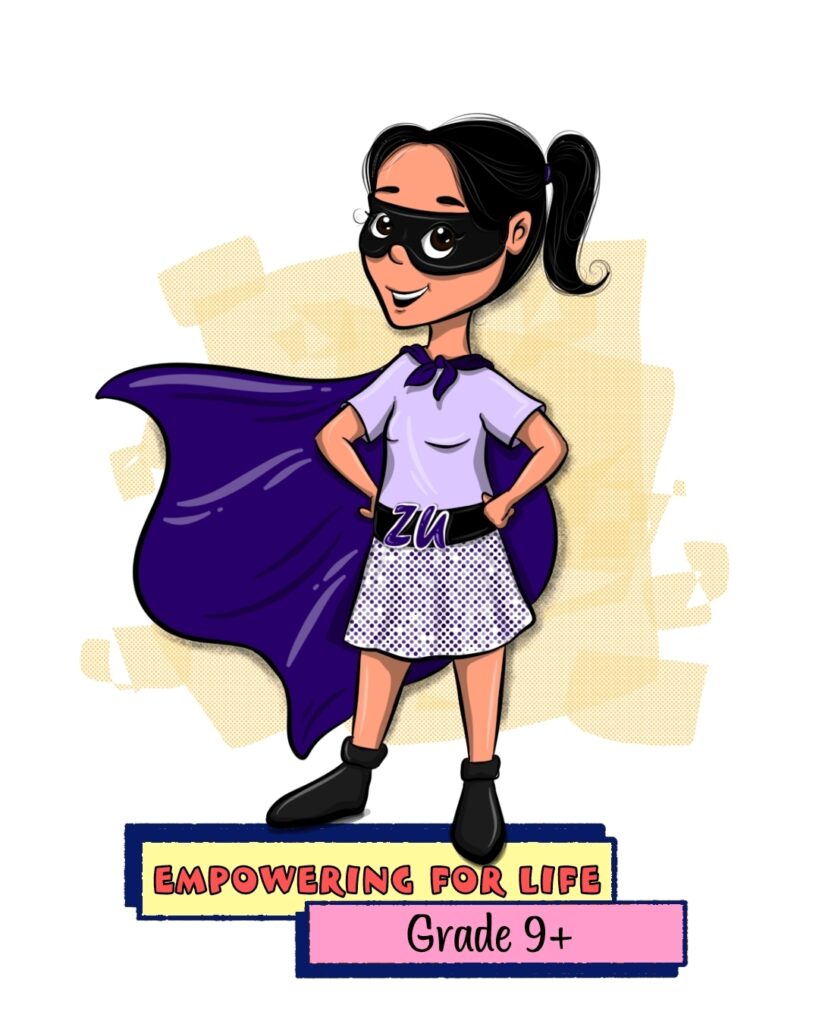Promoting Personal Health and Wellness
Inadequate knowledge of personal health and wellness can lead to poor health outcomes in Indian children, including malnutrition, obesity, dental decay, and other preventable health conditions.
Teaching about Promoting Personal Health and Wellness at a young age helps children in developing healthy habits, developing self-care skills, building confidence, fostering independence and empower them to advocate for themselves:
In our classes on Promoting Personal Health and Wellness, we enable students to
- Practice appropriate hygiene habits.
- Get an appropriate amount of sleep and rest.
- Learning about what can lead to vision and hearing impairment.
- Prevent damage from the sun.
- Practice behaviours that prevent any infectious or chronic diseases.
- Practice behaviours that promote mental and emotional well-being.
- Practice behaviours that prevent foodborne and waterborne illnesses.
- Prevent serious health problems that result from common chronic diseases and conditions among youth, such as allergies, asthma, diabetes, and epilepsy.
- Use healthcare services to address common infectious diseases and manage chronic diseases and conditions.
- Seek out healthcare professionals for appropriate screenings and examinations.
- Prevent health problems that result from fads or trends.
Each lesson is designed meticulously with the help of global experts, our classes are not only age-appropriate but also culturally appropriate according to the region and state you are watching the classes in. We also customize the classes to fit the requirements of each school.
We are ZatchUp and we are dedicated to empowering your child to make healthy and safe life choices.
Grade wise learning objective
We follow an 8-step learning process to empower the kids for life. To learn more about our method of teaching, click here.
KG – Grade 2
- Step One: Step one is Understaning the Core Concept : We enable Students to comprehend core concepts related to our all health and safety courses such as consent, violence prevention
- Identify the proper steps for brushing and flossing teeth daily.
- Explain why hygiene is important for good health.
- Identify the benefits of personal health care practices such as washing hair and bathing regularly.
- Explain the importance and steps of proper hand washing.
- Explain why sleep and rest are important for proper growth and good health.
- Explain how hearing can be damaged by loud noise.
- Identify ways to protect vision or hearing.
- List ways to prevent harmful effects of the sun.
- Identify different ways that disease-causing germs are transmitted.
- Identify ways to prevent the spread of germs that cause common infectious diseases.
- Identify food and non-food triggers that are common causes of allergic reactions.
- Explain that food and water can contain germs that can cause illness.
- Identify food and water safety strategies that can control germs that cause foodborne and waterborne illnesses.
- Identify proper steps for treating a wound to reduce chances of infection.
- Identify ways to stay safe around chemicals used for cleaning and disinfection, including alcohol-based hand rubs and sanitizers. ,
- Step Two : Second step is to Understand Influences : We enable Students to analyze the influence of family, peers, culture, media, technology, and other factors on their health and Safety.
- Identify how family can influence personal health and wellness practices and behaviors.
- Identify how school can influence personal health and wellness practices and behaviors.
- Identify how media and technology can influence personal health and wellness practices and behaviors.
- Describe positive influences on personal health and wellness practices and behaviors.
- Describe negative influences on personal health and wellness practices and behaviors.
- Step Three : Third step is to learn to access Information : We enable students to access valid information, products, and services to ensure good health and safety.
- Identify trusted adults at home who can help promote personal health and wellness.
- Identify trusted adults and professionals in school who can help promote personal health and wellness (e.g., school nurse, counselor, classroom teacher).
- Identify trusted adults and professionals in the community who can help promote personal health and wellness (e.g., healthcare provider, social workers, police officer, religious leaders, mentors).
- Explain how to locate school health helpers who can help promote personal health and wellness (e.g., school nurse, counselor, classroom teacher).
- Explain how to locate community health helpers who can help promote personal health and wellness (e.g., healthcare provider, police officer, firefighter, paramedic, counselor).
- Step Four: Fourth step is to learn Interpersonal Communication : We enable students to use interpersonal communication skills to enhance health and reduce all health risks.
- Demonstrate how to effectively communicate needs, wants, and feelings in healthy ways to enhance personal health and wellness.
- Demonstrate effective active listening skills including paying attention, and verbal and nonverbal feedback to enhance personal health and wellness.
- Demonstrate effective refusal skills, including firmly saying “no” and moving away, to avoid participating in behaviors that negatively affect personal health and wellness.
- Demonstrate how to communicate care and concern for others.
- Step Five : Fifth step is to learn to make decisions : We enable students to use decision-making skills to enhance healthly behaviour.
- Identify situations that need a decision related to personal health and wellness (e.g., washing hands before eating, wearing sun protection, brushing teeth daily).
- Identify how family, peers, culture, technology, or media influence a personal health or wellness- related decision.
- Explain the potential positive and negative outcomes from personal health or wellness-related decisions.
- Describe when help is needed and when it is not needed to make a personal health or wellness- related decision.
- Step Six : Sixth step is to learn to Set Goals : We enable Students to set the right goals to enhance their health and keep themselves safe.
- Identify a realistic short-term goal to improve a personal health and wellness-related practice.
- Take steps to achieve the goal to improve personal health and wellness.
- Identify people who can help achieve a personal health and wellness-related goal.
- Step Seven : Seventh Step is learn Self-Management : We enable students to practice health-enhancing behaviours and reduce health risks.
- Identify personal health and wellness-related practices that reduce or prevent health risks.
- Demonstrate positive personal health and wellness-related practices.
- Commit to practicing positive personal health and wellness-related behaviors.
- Step Eight : Eigth step is learn to Advocate : We enable Students to advocate not only for personal, but also for family, and community health.
- Make requests to others (e.g., family members) to promote positive personal health and wellness- related practices.
- Demonstrate how to encourage peers to make positive personal health and wellness-related choices.
Grade 3 – Grade 5
- Step One: Step one is Understanding the Core Concept : We enable Students to comprehend core concepts related to our all health and safety courses such as consent, violence prevention
- Describe the benefits of personal care practices such as brushing and flossing teeth daily, washing hair, and bathing regularly.
- Explain why sleep and rest are important for proper growth and good health.
- Explain how hearing can be damaged by loud sounds.
- Describe how vision can be damaged.
- Describe ways to prevent vision or hearing damage.
- Explain benefits of proper hygiene practices for healthy eyes and vision (e.g., contact lens hygiene).
- Describe ways to prevent harmful effects of the sun.
- Explain the difference between infectious diseases and non-infectious diseases.
- Describe ways that common infectious diseases are transmitted.
- Describe ways to prevent the spread of germs that cause infectious diseases.
- Describe symptoms that occur when a person sick.
- Identify health problems associated with common childhood chronic conditions (e.g., asthma, allergies, diabetes, and epilepsy).
- Describe the symptoms of someone who is seriously ill and needs immediate medical attention.
- Describe the importance of seeking help and treatment for common infectious diseases.
- Describe how foodborne and waterborne illnesses can spread at school or in the community.
- Describe how germs can spread from direct and indirect person-to-person contact.
- Describe how to keep food and water safe from harmful germs.
- Explain how hand washing removes germs and chemicals from hands to protect the health of oneself and others. ,
- Explain how alcohol-based hand rubs and sanitizers work and when and how to properly and safely use them. ,
- Explain the difference between cleaning and disinfecting. ,
- Step Two : Second step is to Understand Influences : We enable Students to analyze the influence of family, peers, culture, media, technology, and other factors on their health and Safety.
- Identify how culture influences personal health and wellness-related practices and behaviors.
- Identify how peers influence personal health and wellness-related practices and behaviors.
- Identify how community influences personal health and wellness-related practices and behaviors.
- Describe how family and culture influence personal health and wellness-related practices and behaviors.
- Describe how school and community settings influence personal health and wellness-related practices and behaviors.
- Describe how media and technology influence personal health and wellness-related practices and behaviors.
- Describe how peers influence personal health and wellness-related practices and behaviors.
- Step Three : Third step is to learn to access Information : We enable students to access valid information, products, and services to ensure good health and safety.
- Describe characteristics of valid personal health and wellness information.
- Describe characteristics of valid personal health and wellness products.
- Describe characteristics of valid personal health and wellness services.
- Demonstrate how to locate sources of valid personal health and wellness information.
- Step Four: Fourth step is to learn Interpersonal Communication : We enable students to use interpersonal communication skills to enhance health and reduce all health risks.
- Demonstrate effective verbal and nonverbal communication skills to enhance personal health and wellness.
- Explain how to be empathetic and compassionate toward others.
- Demonstrate effective peer resistance skills to avoid or reduce participating in behaviors that can negatively affect personal health and wellness.
- Demonstrate healthy ways to manage to avoid or reduce participating in behaviors that can negatively affect personal health and wellness.
- Demonstrate how to effectively ask for help to improve personal health and wellness.
- Demonstrate how to effectively communicate support for others to improve their personal health and wellness.
- Step Five : Fifth step is to learn to make decisions : We enable students to use decision-making skills to enhance healthly behaviour.
- Identify situations that need a decision related to personal health and wellness.
- Decide when help is needed and when it is not needed to make a personal health and wellness-related decision.
- Explain how family, culture, peers, technology, or media influence a personal health and wellness-related decision.
- Identify options and their potential outcomes when making a personal health and wellness- related decision.
- Choose a healthy option when making a personal health and wellness-related decision.
- Describe the final outcome of a personal health and wellness-related decision.
- Step Six : Sixth step is to learn to Set Goals : We enable Students to set the right goals to enhance their health and keep themselves safe.
- Set a realistic goal to improve a personal health and wellness-related practice.
- Track progress toward achieving a personal health and wellness-related goal.
- Identify resources that can help achieve a personal health and wellness-related goal.
- Step Seven : Seventh Step is learn Self-Management : We enable students to practice health-enhancing behaviours and reduce health risks.
- Describe practices and behaviors that reduce or prevent personal health and wellness-related risks.
- Demonstrate positive personal health and wellness-related practices and behaviors.
- Commit to practicing positive personal health and wellness-related behaviors.
- Step Eight : Eigth step is learn to Advocate : We enable Students to advocate not only for personal, but also for family, and community health.
- Give factual information to improve the personal health and wellness of others.
- State personal beliefs to improve the personal health and wellness of others.
- Demonstrate how to persuade others to make positive personal health and wellness-related choices.
Grade 6 – Grade 8
- Step One: Step one is Understanding the Core Concept : We enable Students to comprehend core concepts related to our all health and safety courses such as consent, violence prevention
- Summarize the benefits of good hygiene practices for promoting health and maintaining positive social relationships.
- Summarize the benefits of getting proper rest and sleep for healthy growth and development.
- Identify common causes of noise-induced hearing loss.
- Describe appropriate ways to protect vision and hearing.
- Describe proper hygiene practices for healthy eyes and vision (e.g., contact lens hygiene).
- Summarize actions to take to protect oneself against potential damage from exposure to the sun.
- Explain the difference between infectious, noninfectious, and chronic diseases.
- Summarize the symptoms of someone who is sick or getting sick.
- Summarize the symptoms of someone who is seriously ill and needs immediate medical attention, including attention for mental health.
- Describe the importance of seeking help and treatment for common infectious diseases, chronic diseases, and mental illnesses.
- Summarize ways that common infectious diseases are transmitted.
- Summarize health practices to prevent the spread of infectious diseases that are transmitted by food, water, air, indirect contact, and person-to-person contact.
- Describe food and water safety strategies that can control germs that cause foodborne and waterborne illnesses.
- Identify appropriate situations for using different hand hygiene approaches (e.g., hand washing, alcohol- based hand rubs and sanitizers). ,
- Explain when surfaces or objects should be cleaned, disinfected, or both; which cleaning agents are appropriate; and how to safely apply them. ,
- Explain ways to prevent the spread of germs that cause infectious diseases by not having sex, not touching blood, and not touching used hypodermic needles.
- Explain behavioral and environmental factors that contribute to major chronic diseases and mental illnesses.
- Describe how a sedentary lifestyle contributes to chronic disease.
- Describe the potential health and social consequences of popular fads or trends.
- Step Two : Second step is to Understand Influences : We enable Students to analyze the influence of family, peers, culture, media, technology, and other factors on their health and Safety.
- Explain how school rules, community norms, and public health policies or laws (e.g., hand hygiene policies) influence personal health and wellness-related practices and behaviors.
- Explain how perceptions of norms influence healthy and unhealthy personal health and wellness-related practices and behaviors.
- Explain how social expectations influence healthy and unhealthy personal health and wellness-related practices and behaviors.
- Explain how personal values and beliefs influence personal health and wellness-related practices and behaviors.
- Describe how some personal health risk behaviors, such as using alcohol and other drugs, influence the likelihood of engaging in other unhealthy personal health and wellness-related behaviors.
- Analyze how family and culture influence personal health and wellness-related practices and behaviors.
- Analyze how school and community influence personal health and wellness-related practices and behaviors.
- Analyze how media and technology influence personal health and wellness-related practices and behaviors.
- Analyze how peers influence personal health and wellness-related practices and behaviors.
- Step Three : Third step is to learn to access Information : We enable students to access valid information, products, and services to ensure good health and safety.
- Analyze the validity of personal health and wellness information (e.g., differentiate between scientifically or medically accurate content and advertising, including sponsored content).
- Analyze the validity of personal health and wellness products.
- Describe situations that call for professional personal health and wellness services.
- Determine the availability of valid personal health and wellness products.
- Access valid personal health and wellness information from home, school, or community.
- Locate valid personal health and wellness products when needed or appropriate.
- Step Four: Fourth step is to learn Interpersonal Communication : We enable students to use interpersonal communication skills to enhance health and reduce all health risks.
- Demonstrate the use of effective verbal and nonverbal communication skills to enhance personal health and wellness.
- Demonstrate effective peer resistance skills to avoid or reduce participating in behaviors that can negatively affect personal health and wellness.
- Demonstrate effective negotiation skills to avoid or reduce participating in behaviors that can negatively affect personal health and wellness.
- Demonstrate how to effectively ask for assistance to improve personal health and wellness and the health of others.
- Demonstrate how to effectively communicate empathy and support for others to improve their personal health and wellness.
- Step Five : Fifth step is to learn to make decisions : We enable students to use decision-making skills to enhance healthly behaviour.
- Identify circumstances that help or hinder making a healthy decision related to personal health and wellness.
- Determine when personal health and wellness situations require a decision.
- Distinguish when decisions about personal health and wellness should be made individually or with the help of others.
- Explain how family, culture, technology, media, peers, and personal beliefs affect a personal health and wellness-related decision.
- Distinguish between healthy and unhealthy alternatives of a personal health and wellness- related decision.
- Predict the potential outcomes of healthy and unhealthy alternatives to a personal health and wellness- related decision.
- Choose a healthy alternative when making a personal health and wellness-related decision.
- Analyze the effectiveness of a final outcome of a personal health and wellness-related decision.
- Step Six : Sixth step is to learn to Set Goals : We enable Students to set the right goals to enhance their health and keep themselves safe.
- Assess personal health and wellness-related practices.
- Set a realistic goal to improve a positive personal health and wellness-related practice.
- Assess the barriers to achieving a personal health and wellness-related goal.
- Apply strategies to overcome barriers to achieving a personal health and wellness-related goal.
- Use strategies and skills to achieve a personal health and wellness-related goal.
- Step Seven : Seventh Step is learn Self-Management : We enable students to practice health-enhancing behaviours and reduce health risks.
- Explain the importance of being responsible for personal health and wellness-related behaviors.
- Analyze personal health and wellness-related practices and behaviors that reduce or prevent health risks.
- Demonstrate healthy practices and behaviors to improve the personal health and wellness of oneself and others.
- Commit to practicing positive personal health and wellness-related behaviors.
- Step Eight : Eigth step is learn to Advocate : We enable Students to advocate not only for personal, but also for family, and community health.
- State a health-enhancing position, supported with accurate information, to improve the personal health and wellness of others.
- Persuade others to make positive personal health and wellness-related choices.
- Collaborate with others to advocate for individuals, families, and schools to be healthy.
- Demonstrate how to adapt a personal health and wellness-related message for different audiences.
Grade 9 – Grade 12
- Step One: Step one is Understanding the Core Concept : We enable Students to comprehend core concepts related to our all health and safety courses such as consent, violence prevention
- Analyze the personal physical, emotional, mental, and social health; educational; and vocational performance benefits of rest and sleep.
- Summarize personal strategies for reducing hearing damage due to exposure to loud sounds.
- Summarize personal strategies for avoiding vision damage.
- Explain how eye infections occur and how to prevent or minimize risk with healthy hygiene.
- Summarize personal strategies for minimizing potential harm from sun exposure.
- Summarize how common infectious diseases are transmitted by indirect contact and person-to-person contact.
- Analyze how common foodborne and waterborne diseases are transmitted.
- Explain how regular cleaning, disinfection, and hand hygiene at key times improves personal and population health and prevents the spread of disease. ,
- Explain the relationship between intravenous drug use and transmission of bloodborne diseases such as HIV and hepatitis.
- Summarize ways to prevent the spread of germs that cause infections diseases such as HIV by not having sex, not touching blood, and not touching used hypodermic needles.
- Analyze behavioral and environmental factors that contribute to major chronic diseases and mental illness.
- Analyze health practices to prevent the spread of infectious diseases that are transmitted by food, water, air, indirect contact, and person-to-person contact.
- Justify why it is important to seek help and treatment for common infectious diseases, chronic diseases, and mental illnesses.
- Summarize important health screenings, immunizations, checkups, and examinations necessary to maintain good health.
- Summarize the potential health and social consequences of popular fads or trends.
- Step Two : Second step is to Understand Influences : We enable Students to analyze the influence of family, peers, culture, media, technology, and other factors on their health and Safety.
- Explain how public health policies influence personal health and wellness-related practices and behaviors.
- Analyze how culture supports and challenges personal health and wellness-related beliefs, practices, and behaviors.
- Analyze how peers and perceptions of norms influence healthy and unhealthy personal health and wellness-related practices and behaviors.
- Analyze how personal attitudes, values, and beliefs influence healthy and unhealthy personal health and wellness-related practices and behaviors.
- Analyze how some health risk behaviors influence the likelihood of engaging in other unhealthy personal health and wellness-related behaviors.
- Analyze how laws, rules, and regulations influence health promotion and disease prevention.
- Analyze how school and community settings influence personal health and wellness practices and behaviors.
- Analyze how media and technology influence personal, family, and community health and wellness.
- Differentiate relevant influences, including family, culture, peers, school, community, media, technology and public health policies, on personal health and wellness-related practices and behaviors.
- Analyze the factors that influence opportunities to obtain safe, accessible, equitable, and affordable products and services that support health and wellness for oneself and others.
- Step Three : Third step is to learn to access Information : We enable students to access valid information, products, and services to ensure good health and safety.
- Evaluate the validity of personal health and wellness information (e.g., differentiate between scientifically or medically accurate content and advertising, including sponsored content).
- Evaluate the validity of personal health and wellness products.
- Evaluate the validity of personal health and wellness services.
- Determine the accessibility of valid personal health and wellness products.
- Determine when professional personal health and wellness services may be required.
- Determine the accessibility of valid personal health and wellness services.
- Use resources that provide valid personal health and wellness information.
- Use valid personal health and wellness products when needed or appropriate.
- Use valid personal health and wellness services when needed or appropriate.
- Step Four: Fourth step is to learn Interpersonal Communication : We enable students to use interpersonal communication skills to enhance health and reduce all health risks.
- Demonstrate effective communication skills to enhance personal health and wellness.
- Demonstrate effective peer resistance, negotiation, and collaboration skills to avoid engaging in practices and behaviors that can negatively affect personal health and wellness.
- Demonstrate how to effectively ask for assistance to improve personal health and wellness.
- Demonstrate how to effectively offer assistance to improve the personal health and wellness of others.
- Step Five : Fifth step is to learn to make decisions : We enable students to use decision-making skills to enhance healthly behaviour.
- Examine barriers that can hinder choosing healthy alternatives in making a personal health and wellness-related decision.
- Determine the value of applying thoughtful decision making regarding a personal health and wellness-related problem.
- Justify when individual or collaborative decision making is appropriate for a personal health and wellness-related problem.
- Analyze how family, culture, technology, media, peers, and personal beliefs affect a personal health and wellness-related decision.
- Generate alternatives when making a decision related to personal health and wellness.
- Predict potential short- and long-term consequences of alternatives to a health and wellness- related decision.
- Choose a healthy alternative when making a personal health and wellness-related decision.
- Evaluate the effectiveness of personal health and wellness-related decisions.
- Step Six : Sixth step is to learn to Set Goals : We enable Students to set the right goals to enhance their health and keep themselves safe.
- Assess personal health and wellness-related practices and behaviors.
- Set a realistic goal to improve a personal health and wellness-related practice.
- Assess the barriers to achieving a personal health and wellness-related goal.
- Develop a plan to attain a personal health and wellness-related goal.
- Implement strategies, including self-monitoring, to achieve a personal health and wellness-related goal.
- Use strategies to overcome barriers to achieve a personal health and wellness-related goal.
- Formulate a long-term plan to achieve a personal health and wellness-related goal.
- Step Seven : Seventh Step is learn Self-Management : We enable students to practice health-enhancing behaviours and reduce health risks.
- Analyze the role of individual responsibility in enhancing personal health and wellness.
- Evaluate personal health and wellness-related practices and behaviors that reduce or prevent health risks.
- Demonstrate healthy practices and behaviors to improve the health and wellness of oneself and others.
- Commit to practicing positive personal health and wellness-related behaviors.
- Step Eight : Eigth step is learn to Advocate : We enable Students to advocate not only for personal, but also for family, and community health.
- Use peer and societal norms, based on accurate health information, to formulate positive personal health and wellness-related messages.
- Persuade and support others to make positive choices related to personal health and wellness.
- Collaborate with others to advocate for improving personal, family and community health and wellness.
- Encourage school and community environments to promote the health and wellness of others.
- Adapt personal health and wellness messages and communication techniques for a specific target audience.
- Persuade school and community leaders about the importance of ensuring there are safe, accessible, equitable, and affordable personal health and wellness opportunities, products, and services to improve the health of oneself and others.

